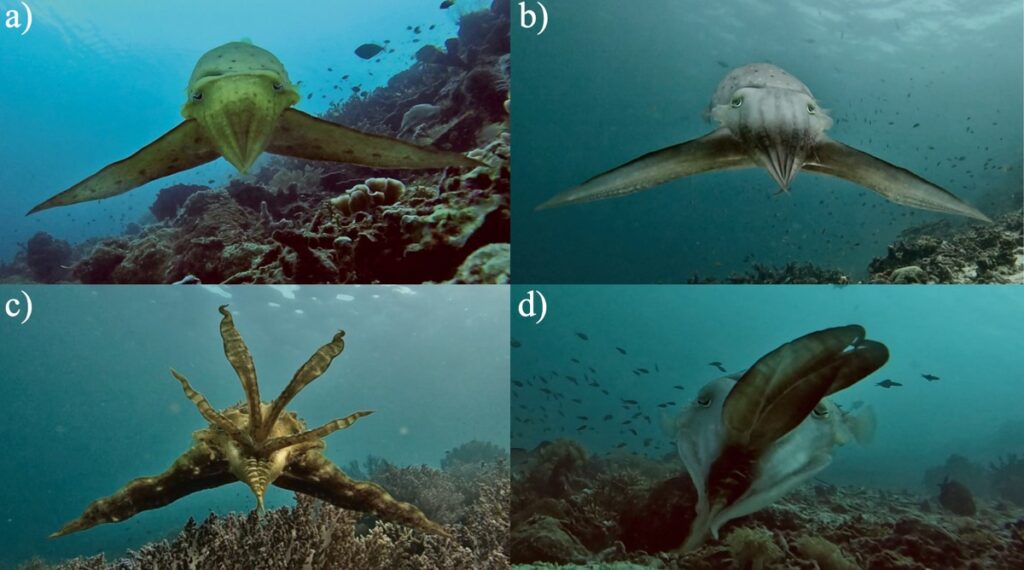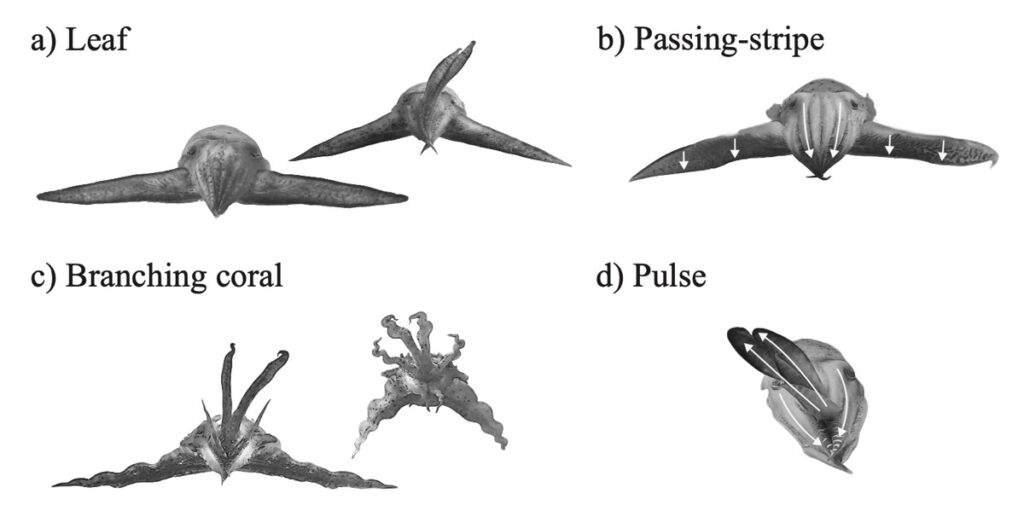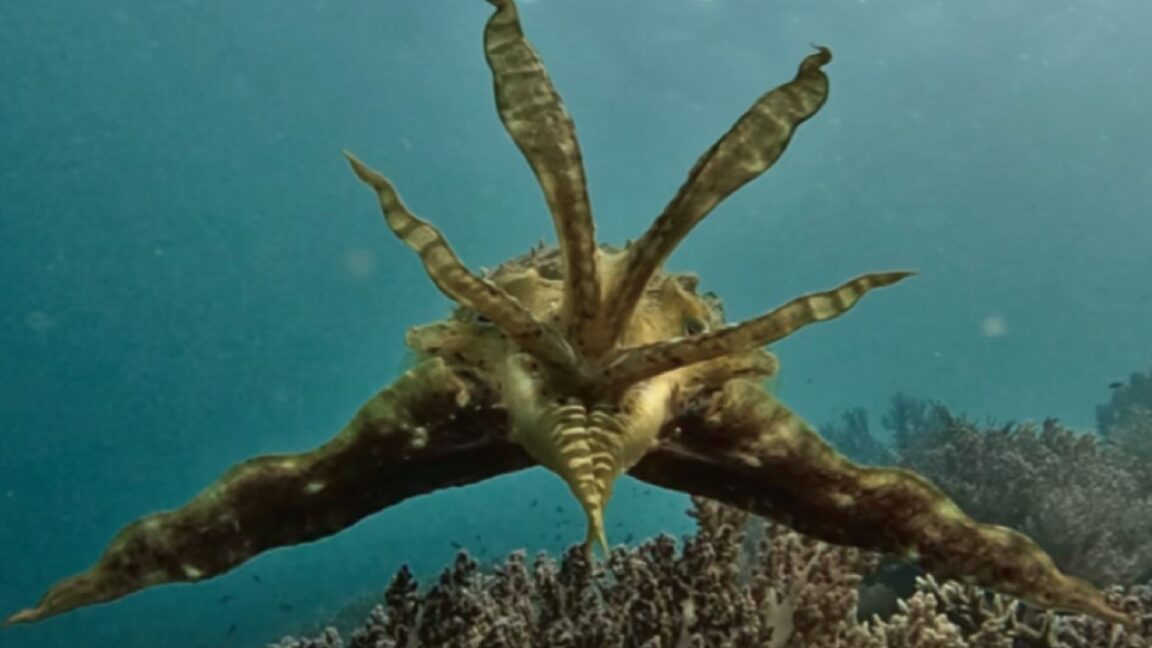They can take on the features of a mangrove leaf or branching coral, or run dark stripes down their bodies.
Crafty cuttlefish employ several different camouflaging displays while hunting their prey, according to a new paper published in the journal Ecology, including mimicking benign ocean objects like a leaf or coral, or flashing dark stripes down their bodies. And individual cuttlefish seem to choose different preferred hunting displays for different environments.
It's well-known that cuttlefish and several other cephalopods can rapidly shift the colors in their skin thanks to that skin's unique structure. As previously reported, squid skin is translucent and features an outer layer of pigment cells called chromatophores that control light absorption. Each chromatophore is attached to muscle fibers that line the skin's surface, and those fibers, in turn, are connected to a nerve fiber. It's a simple matter to stimulate those nerves with electrical pulses, causing the muscles to contract. And because the muscles are pulling in different directions, the cell expands, along with the pigmented areas, changing the color. When the cell shrinks, so do the pigmented areas.
Underneath the chromatophores, there is a separate layer of iridophores. Unlike the chromatophores, the iridophores aren't pigment-based but are an example of structural color, similar to the crystals in the wings of a butterfly, except a squid's iridophores are dynamic rather than static. They can be tuned to reflect different wavelengths of light. A 2012 paper suggested that this dynamically tunable structural color of the iridophores is linked to a neurotransmitter called acetylcholine. The two layers work together to generate the unique optical properties of squid skin.
And then there are leucophores, which are similar to the iridophores, except they scatter the full spectrum of light, so they appear white. They contain reflectin proteins that typically clump together into nanoparticles so that light scatters instead of being absorbed or directly transmitted. Leucophores are mostly found in cuttlefish and octopuses, but there are some female squid of the genus Sepioteuthis that have leucophores that they can "tune" to only scatter certain wavelengths of light. If the cells allow light through with little scattering, they’ll seem more transparent, while the cells become opaque and more apparent by scattering a lot more light.
Scientists learned in 2023 that the process by which cuttlefish generate their camouflage patterns is significantly more complex than scientists previously thought. Specifically, cuttlefish readily adapted their skin patterns to match different backgrounds, whether natural or artificial. And the creatures didn't follow the same transitional pathway every time, often pausing in between. That means that contrary to prior assumptions, feedback seems to be critical to the process, and the cuttlefish were correcting their patterns to match the backgrounds better.
Four distinctive displays


All those elements combine to make cuttlefish the master “hypnotists of the underwater world,” co-author Matteo Santon of the University of Bristol in England told New Scientist. He and his colleagues spent several months filming 98 cuttlefish hunting prey in Indonesia. Santon was particularly interested in studying the cuttlefish's ability to adopt moving stripe patterns (the topic of a forthcoming paper) and soon realized that his subjects exhibited a range of four distinct hunting displays when approaching their prey, each with a different coloration, texture, and body posture.
In the "Leaf" display, for instance, the cuttlefish stretches its lateral arms horizontally, tucking its other arms into a cone while turning its body olive-green, and approaching the prey very slowly—as if it were a floating mangrove leaf being carried along by the current. In the "Branching Coral" display, the cuttlefish raises its two central arms and splays its remaining arms in front of the body while turning yellow and orange. This might serve to help the cuttlefish hide among staghorn corals to conceal its approach to prey.
For the "Passing Stripe" display, the cuttlefish took on a dark gray hue and flashed a downward-moving black stripe along its body. This serves as a form of motion camouflage, as the downward motion of the stripe counters the more threatening expanding motion as the cuttlefish approaches its prey. In the "Pulse" display, the two lateral arm pairs point forward in a tight zone, while the central arms extend upward and out wide, as pulses of dark color play out on the overall gray coloration of the body. The advantages gained by this are less clear, per the authors, but it might serve to minimize the cuttlefish profile from the perspective of its prey (e.g., crabs).
The most commonly used patterns were the branching coral, passing stripe, and leaf displays, with pulse displays only accounting for about 11 percent of those observed. Sixty-two of the cuttlefish were filmed more than once and used two or more different hunting displays. "This suggests that this variability is unlikely explained by individual cuttlefish personality," the authors wrote. In fact, it demonstrates that "cuttlefish, in different environmental contexts in the wild, show a much broader behavioral repertoire than when housed in the laboratory."
Ecology, 2025. DOI: 10.1002/ecy.70021 (About DOIs).
Hope you enjoyed this news post.
Thank you for appreciating my time and effort posting news every day for many years.
News posts... 2023: 5,800+ | 2024: 5,700+ | 2025 (till end of January): 487
RIP Matrix | Farewell my friend ![]()



3175x175(CURRENT).thumb.jpg.b05acc060982b36f5891ba728e6d953c.jpg)
Recommended Comments
There are no comments to display.
Join the conversation
You can post now and register later. If you have an account, sign in now to post with your account.
Note: Your post will require moderator approval before it will be visible.